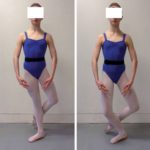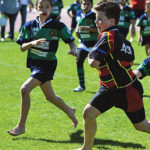Parents overestimate wear times

The circular outline of the temperature sensor used to collect data is visible in this Mitchell-Ponseti brace sandal. (Photo courtesy of Lewis E. Zionts, MD.)
By Peaches Yeilding
Researchers who used temperature-sensitive devices to measure brace-use adherence in children with clubfoot found parents overestimate brace wear time when reporting to clinicians and that children are not in their braces as long as their doctors recommend.
“We found a significant difference between reported and actual brace usage,” said lead study author Lewis E. Zionts, MD, an orthopedic surgeon at the Orthopaedic Institute for Children in Los Angeles. Brace use recorded by sensors was 62% of that recommended by physicians and 77% of what parents reported. His group’s findings were published in October in the Journal of Bone and Joint Surgery.
The Ponseti method—the gold standard for treatment of clubfoot—has a high success rate when patients comply with postcorrective brace protocols, and relapse of deformity is mostly attributed to noncompliance (See “Keeping kids in braces can prevent clubfoot relapse,” February 2016, page 15). “Following doctor-recommended brace use is far and away the most important way to prevent relapse,” Zionts said.
“An objective measurement is important because the time children actually are in the brace is unknown. We know parents overestimate, but not how much,” said Jose A. Morcuende, MD, PhD, a pediatric orthopedic surgeon at the University of Iowa Hospitals and Clinics in Iowa City who was not involved in the study.
Study participants wore Mitchell-Ponseti braces, which Zionts and his colleagues customized by stapling a button-sized wireless temperature data logger in the sandal and drilling a hole in the back of the rubber liner so the sensor could detect body temperature. The sensors featured programmable data acquisition and a storage capacity of 2.048 readings, enough for continuous sampling every 90 minutes for four months. Both heels had a sensor, and sampling was offset so data were collected every 45 minutes.
Study authors recruited 48 participants who had completed the first three months of full-time brace use, with 12 patients enrolled in four age-based groups: six to 12 months, 13 to 24 months, 25 to 36 months, and 37 to 48 months. They instructed parents to use the brace 16 hours a day until their child was a year old, 14 hours per day for children aged between 12 and 24 months, 12 hours a day for those aged between 24 and 36 months, and 10 hours a day for individuals aged between 36 and 48 months. Forty-four participants completed the study.
Parents were instructed to use braces for a mean of 12.6 hours a day, but sensor data indicated actual usage was eight hours per day (median). For all participants, adherence ranged from 5% to 125%. Parents’ reports were inflated, averaging 11.3 hours of daily brace use; the accuracy of those reports was 77%.
Eight of the 44 demonstrated relapse; brace application for those patients averaged five hours a day, and their mean adherence was 40%, compared with 64% for those who did not relapse.
Zionts’s data suggest that, on average, eight hours or more of daily brace use helps prevent relapse, and five hours is not enough. “This information is good to have,” said Morcuende, “but we can’t draw major conclusions because the sample size was small.”
Zionts agreed a larger cohort is needed to answer the question of how many hours braces must be worn to prevent relapse.
Morcuende pointed out that the study population was not representative of the general population; 57% of participants made less than $20,000 a year and another 35% made between $20,000 and $39,999. In addition, 51% of parents were unmarried, and 39% had a high school education or less.
“Data have been mixed in previous studies,” said Zionts. “Some earlier research has found socioeconomic factors, such as low education levels and single-parent status, can reduce parental compliance.” In a 2010 review, Zionts and colleagues found giving parents written instructions tailored to their education level, as well as explanatory videos to take home, may help improve adherence.
“The key finding is children are not in the braces as long as their doctors recommend, and this is a nice study with objective measurements,” Morcuende said.
“Our findings are a good starting point to develop braces with embedded sensors so that objective, accurate measurements of brace use routinely can be obtained and help identify which patients are receiving inadequate time in their brace. These patients can be targeted for more effective counseling,” said Zionts.
Peaches Yeilding is a freelance writer in Washington, DC.
Sources:
Sangiorgio SN, Ho NC, Morgan RD, et al. The objective measurement of brace-use adherence in the treatment of idiopathic clubfoot. J Bone Joint Surg Am 2016;5(98):1589-1605.
Zionts LE, Dietz FR. Bracing following correction of idiopathic clubfoot using the Ponseti method. J Am Acad Orthop Surg 2010;18(8):486-493.





